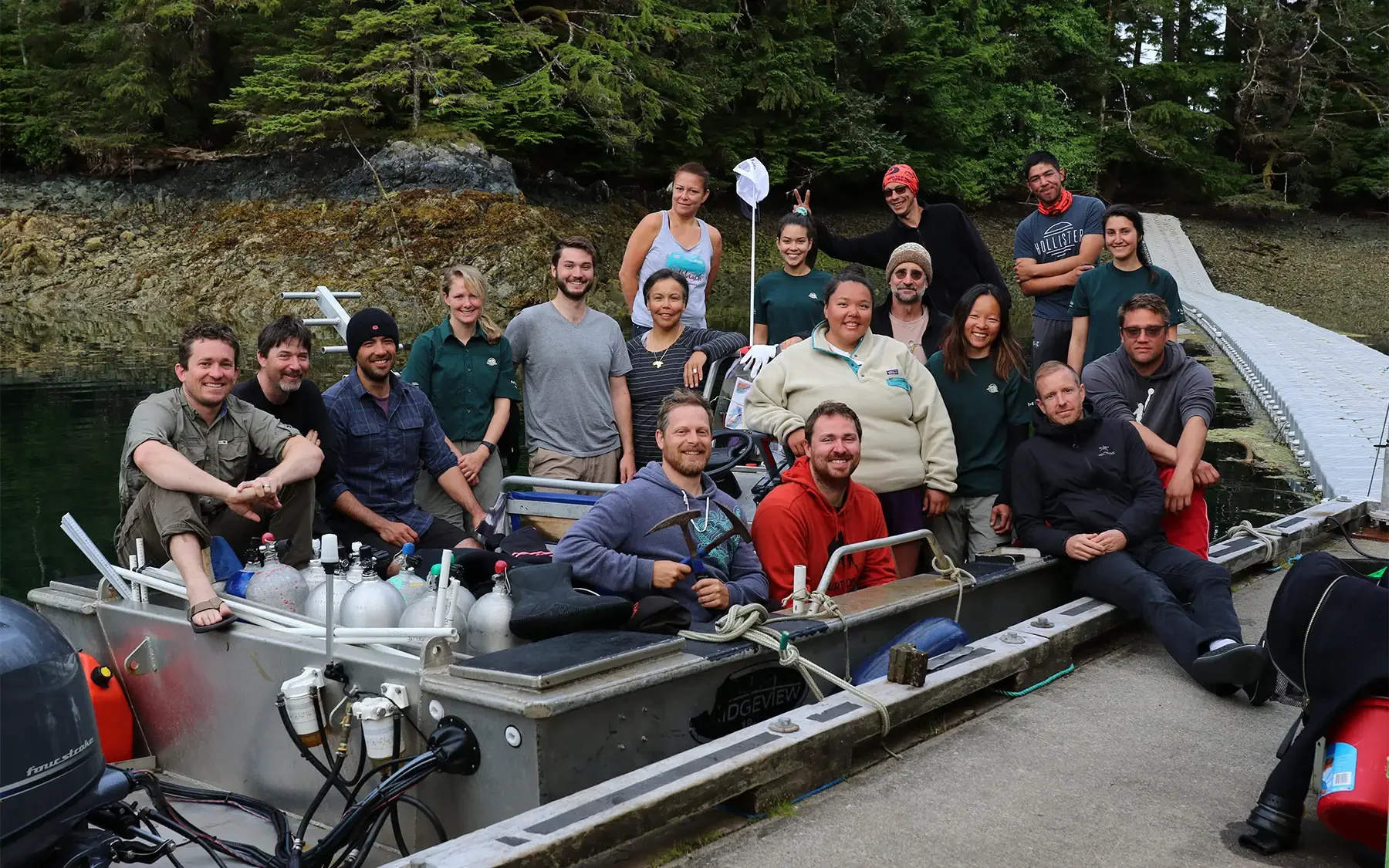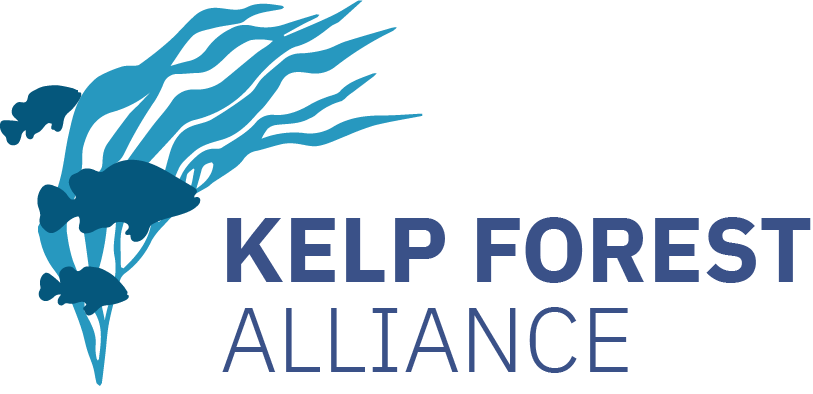Key takeaways
This project engaged rightsholders and stakeholders in the restoration process, which enabled inclusive representation and provided tangible benefits due to the diverse sources of knowledge and expertise.
Monitoring at control sites helped determine whether population fluctuations at the restoration site were the result of environmental factors or the restoration actions.
Background
Kelp forests along the coast of British Columbia (BC), Canada, have been diminished since the loss of a coastal keystone predator, kuu—sea otter (Enhydra lutris), due to the maritime fur trade. On Xaayda Gwaay—Haida Gwaii, a remote archipelago in northern BC, kuu have been functionally extirpated since the early to mid-1800s. Absence of sea otter predation led to hyperabundance of their invertebrate prey, including sea urchins. In more recent years, dramatic declines of a formerly ubiquitous mesopredator, sunflower star (Pycnopodia helianthoides), from sea star wasting disease has also contributed to high urchin grazing rates. Losses of important predators of urchins and changing ocean conditions that are unfavorable for kelp have further diminished kelp forests here.
The project
To improve kelp forest habitat for culturally and ecologically important kelp-dependent species like northern abalone, rockfishes, herring and salmon, Gwaii Haanas cooperative management partners—Council of the Haida Nation, Parks Canada, and Fisheries and Oceans Canada—worked collaboratively with urchin fishing industry partners to mimic sea otter predation by reducing urchin abundance by 75-95% at the restoration site through commercial fishing, traditional fishing, and cracking of urchins underwater. Importantly, this restoration work is guided by Haida ethics and values (Fig. 1): Yahguudang—Respect, ‘Laa guu ga kanhllns—Responsibility, Gina ’waadluxan gud ad kwaagid—Interconnectedness, Giid tlljuus—Balance, Isda ad dii gii isda—Giving and Receiving, and Gina k’aadang.nga gii uu tll k’anguudang—*Seeking Wise Counsel. Acknowledging the complex nature of ecosystem linkages and dynamic ocean conditions, we gave careful consideration to the restoration method, given that urchins are natural parts of kelp forest communities and that guuding.ngaay—red urchins (*Mesocentrotus franciscanus) can live for over a century. In this case, we decided that targeted red urchin removals, along with removal of less abundant green and purple urchins, could help achieve culturally and ecologically meaningful restoration gains.
The Gwaii Haanas kelp forest restoration site lies within a strict protection zone and Abalone Stewardship Area that is normally closed to commercial urchin fishing, encompassing ~20 hectares of shallow subtidal rocky reef along 3 km of shoreline from 0-15 m depth. Although time-consuming and costly, urchin removal by scuba divers using hand tools ensured that non-target species and habitat were unharmed by restoration activities. Urchin removal and crushing occurred in two events: (1) fall 2018 with 49-person dive days, and (2) spring 2019 with 80-person dive days. These initial efforts removed ~90% of the urchins, reducing urchin densities from ~6.5 to ~0.6 urchins /m2, and we are working with commercial harvesters to annually maintain similarly low urchin densities at the restoration site over the longer term. Gwaii Haanas Parks Canada and the Haida Nation also prioritized sharing guuding.ngaay—red urchin, styuu—green urchin (Strongylocentrotus droebachiensis) and daws styuu—purple urchin (S. purpuratus), which are traditional foods, with local communities as a cultural component of the urchin removals. School programs, outreach at community events, and public and scientific presentations to share knowledge about ecology and traditional Haida values associated with kelp forest ecosystems are also integral to the project.
By collaborating with multiple academic partners, we are leveraging restoration actions to advance knowledge about how kelp restoration alters ecosystem structure and function, including effects on key species. We established permanent monitoring transects to survey for annual changes in algal, invertebrate, and fish communities at the restoration site and a nearby control site. Pre-restoration monitoring occurred in summers 2017 and 2018, and post-restoration monitoring in summers 2019, 2020, and 2021. Research throughout the project includes investigating changes in the growth rates, respiration rates, and food sources for abalone and red urchin, and in red urchin gonad mass.
Some ecosystem responses were rapid. Compared to pre-restoration conditions, post-restoration 2019 surveys showed a 15-fold increase in kelp stipe density and four-fold increase in kelp canopy cover, increased kelp depth from 0.5 to 8 m depth, continued low urchin densities, increased quantity of roe in red urchins, and maintenance of northern abalone densities. Control site surveys provided baselines for natural processes. Ecosystem responses varied between the two post-restoration surveys with much stronger kelp responses in 2019 than in 2020, potentially attributed to differences in kelp recruitment. Post-restoration monitoring and research will continue to track kelp forest community structure and dynamics.
Parks Canada is primarily funding and supporting the five-year project from 2017-2022 for ~$2.9M Cdn. Restoration work is being implemented through in-kind management support from Fisheries and Oceans Canada, and contracted support from Haida Fisheries Program and Pacific Urchin Harvesters Association. Monitoring and research are funded and in-kind from Florida State University, University of Oregon, University of British Columbia, University of New Brunswick, Hakai Institute/Tula Foundation, and Haida Fisheries Program. In-kind longer-term restoration maintenance work is being discussed with the Pacific Urchin Harvesters Association, and additional research funding will be pursued to track longer-term changes.
Lessons learned
Respectfully engaging management partners, collaborators, community values and knowledge systems from the start fosters success. Actively building and maintaining relationships and trust among collaborators right from project inception has been critical to our project success. Broad engagement helps incorporate diverse perspectives and funding support throughout the project. Our guiding principles are based on Haida ethics and values that are supported through cooperative management between the Haida Nation and Canada via the Gwaii Haanas Archipelago Management Board. This co-governance model further prioritizes involvement and capacity building for Haida citizens in restoration and monitoring activities within Haida traditional territory. Together, Haida traditional and western scientific knowledge systems provide critical multi-faceted expertise that draws on strengths of both worldviews. A technical team (with representatives of all collaborators), a higher-level steering committee with representatives from governance bodies, and an external kelp restoration expert all provided guidance for project logistics, monitoring, implementation, and research. Incorporating communications and outreach plans, particularly for local communities and schools, help to establish and maintain community support and foster a broad base of long-lasting knowledge.
Creative partnerships can help achieve longer-term success towards shared conservation goals. By building partnerships with local communities, the commercial urchin fishing association, and fisheries management, we could harvest urchins that had grazed sufficient kelp to develop high quality roe for community food or markets as part of the urchin removals for restoration work. These partnerships may be able to help maintain low urchin densities at the restoration site by working with the commercial fishing association to continue fishing and urchin cracking as part of the red urchin commercial fishing season each year. By allowing a limited Haida-monitored fishery in the closed area, long-term restoration maintenance is possible and may also help reduce urchin densities in adjacent areas.
Staying adaptive and flexible promotes project resilience in light of rapidly changing ecosystem conditions. Differences in kelp recovery between summers 2019 and 2020 reinforced that restoration outcomes are subject to changing ocean conditions and consistent results between years should not necessarily be expected. Changing ocean conditions highlight the benefits of establishing a control site, longer-term site maintenance, monitoring for environmental change, and research to understand restoration-related ecosystem dynamics. For example, in spite of continued low urchin densities at the restoration site, kelp recovery in the second post-restoration year was greatly reduced compared to the first year, and higher seawater temperature may be negatively affecting kelp recruitment and growth; yet the recent natural return of sea otters to Haida Gwaii should maintain and enhance restoration gains when kuu move into the area. When and to what degree these and other changes will happen are unknowns that we will try to anticipate before adjusting plans as needed.
Figure 1 Haida ethics and values as guiding principles. Excerpt from Gwaii Haanas Gina ‘Waadluxan KilGuhlGa Land-Sea-People Management Plan 2018, https://www.pc.gc.ca/en/pn-np/bc/gwaiihaanas/info/consultations/gestion-management-2018 with permission from the Gwaii Haanas Archipelago Management Board and Haida artist Iljuuwaas Tyson Brown.
Chiixuu Tll iinasdll remote field crew including Haida Fisheries Program divers, academic researchers, contract scientific divers, camp cook, and Gwaii Haanas Parks Canada staff. Photo supplied by Ryan Miller/millermarine.ca
Hauling harvested guuding.ngaay red sea urchins onto a transport vessel to bring into town for community food and outreach as part of restoration work. Photo supplied by Charlotte Houston/Parks Canada
Haida staff at Gwaii Haanas delivering school program about kelp restoration and guuding.ngaay, a traditional food. Typical underwater site conditions at the Gwaii Haanas kelp restoration area. Photo supplied by Gwaii Haanas/Parks Canada.
Pre-restoration. Photo supplied by Ryan Miller/millermarine.ca
During restoration work. Photo supplied by Ryan Miller/millermarine.ca
In the first summer post-restoration, where stipe density of annual kelps increased dramatically from 0.09 to 1.33 stipes per m2. Restoration gains were less marked two summers following restoration work at 0.73 stipes per m2. Urchin densities remained much lower than pre-restoration conditions, however, did increase slightly between the first and second post-restoration summers from 0.58 (± 0.15 SE) to 1.05 (± 0.17 SE) urchins per m2, highlighting the need for continued restoration maintenance work. Photo supplied by Ryan Miller/millermarine.ca











